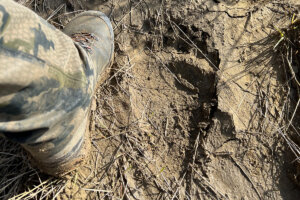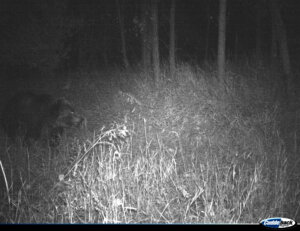An American Prairie employee first found grizzly bear (Ursus arctos) tracks on the PN along the Judith River in early October 2023. Several weeks later, camera traps on the property captured photographs of a grizzly bear.

This is a powerful and historic discovery, as it provides some of the first evidence of grizzly bears in the Missouri River Breaks in about 100 years.
Grizzly bears are well-adapted to life on the prairie and historically occupied much of the Great Plains. This ecosystem provides abundant natural food resources for the species, including fleshy roots, berries, fresh prairie grasses and forbs, rodents, and carrion (including bison carcasses).
While we are celebrating the long-awaited signs of grizzly bears to the American Prairie region, the safety of our visitors is a top priority. We quickly reported the sighting to Montana Fish, Wildlife & Parks, and are working with the agency to convey this information to hunters, visitors, and lessees. We appreciate the cooperation from the department and look forward to continuing collaboration.

Living with bears starts with protecting yourself and your belongings. When visiting any American Prairie property, and especially the PN, please follow these safety guidelines:
- Be alert and watch for signs of bears
- Stay at least 100 yards from bears
- Carry bear spray and know how to use it
- Hike in groups and make noise
- Avoid hiking at dawn, dusk, or at night
- Store food and garbage in bear-proof containers and do not cook in your tent.
- If a bear charges you, stand your ground. Do not run.
- If a bear attacks you, drop facedown to the ground and cover as much of your neck and head as possible.
- MT FWP guidelines state: “Both grizzly bears and black bears pose a threat. In an encounter, the bear’s behavior, rather than its species, should determine how you respond.” Read more here.
- Hunters visiting the PN should exercise additional caution
Recovery of this species in the region has always been a goal of American Prairie. While awaiting their return, American Prairie has worked to restore a habitat suitable for this species. With this bear’s arrival, we can test and continue to evolve our coexistence strategy for grizzly recovery. That strategy includes securing attractants, putting up electric fences around homes and dumpsters, adding bear boxes to campsites, promoting bear awareness, equipping our staff and lessees with bear spray and the training to use it properly, helping to employ range riders on neighboring ranches, building-out the Wild Sky program, and much, much more.
Whether it’s buying land and dedicating it to the restoration of biodiversity or mitigating human-wildlife conflict with large carnivores like grizzly bears, American Prairie’s rewilding work is made possible by donations from supporters like you.
